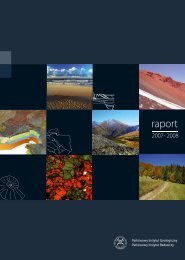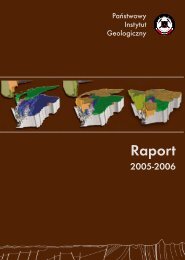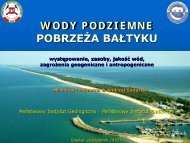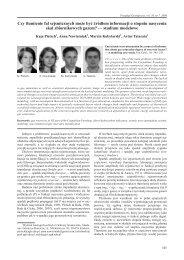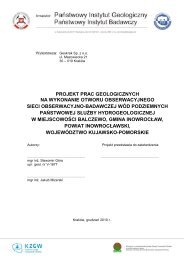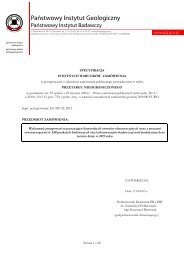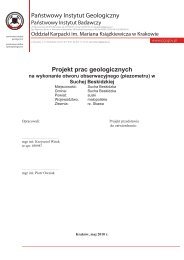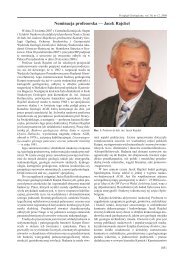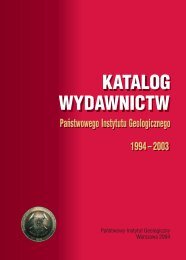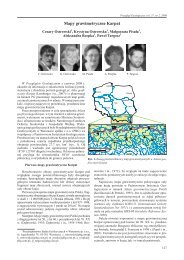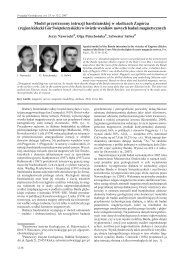Strike-slip tectonics within the SW Baltic Sea and its relationship to ...
Strike-slip tectonics within the SW Baltic Sea and its relationship to ...
Strike-slip tectonics within the SW Baltic Sea and its relationship to ...
Create successful ePaper yourself
Turn your PDF publications into a flip-book with our unique Google optimized e-Paper software.
ing 1997 <strong>and</strong> 1998 cruises were processed at <strong>the</strong><br />
Department of Geophysics, Polish Geological Institute<br />
using FOCUS software. The velocity analysis was<br />
completed at about each 500 CDP, i.e. for about each<br />
3 km. After NMO <strong>and</strong> data stack, post-stack predictive<br />
deconvolution was applied in order <strong>to</strong> remove multiple<br />
reflections related <strong>to</strong> a sea bot<strong>to</strong>m. Migration was not<br />
applied <strong>to</strong> <strong>the</strong> acquired data, as <strong>its</strong> possible effect would<br />
not significantly enhance data quality.<br />
Data quality could be described as moderate <strong>to</strong><br />
very good. Lowest quality characterises areas located<br />
close <strong>to</strong> <strong>the</strong> coastline <strong>and</strong> with thick gravel cover on<br />
sea bot<strong>to</strong>m. Within <strong>the</strong> Bornholm–Darlowo Fault<br />
Zone data quality is good <strong>to</strong> very good, with vertical<br />
resolution in order of a few metres. For <strong>the</strong> entire<br />
acquired seismic data set a major problem during<br />
data interpretation was <strong>the</strong> presence of strong multiple<br />
events related <strong>to</strong> a sea bot<strong>to</strong>m, but for data from<br />
<strong>the</strong> Bornholm–Darlowo Fault Zone, this event did<br />
not significantly influence accuracy of a completed<br />
interpretation.<br />
4. Interpretation of <strong>the</strong> seismic data<br />
The processed seismic data were loaded in<strong>to</strong> <strong>the</strong><br />
L<strong>and</strong>mark Graphics interpretation system, <strong>to</strong>ge<strong>the</strong>r<br />
with available well data that included stratigraphy<br />
<strong>and</strong> time–depth data from selected petroleum wells<br />
drilled by <strong>the</strong> Petrobaltic oil company (Rempel, 1992;<br />
Schlüter et al., 1997). Additionally, selected Petrobaltic<br />
seismic data were also available during interpretation<br />
of shallow high-resolution seismic data. However,<br />
<strong>the</strong>y were available for most western <strong>and</strong> eastern<br />
parts of <strong>the</strong> S <strong>Baltic</strong> <strong>Sea</strong> only; in particular, no<br />
petroleum seismic <strong>and</strong> well data were available from<br />
<strong>the</strong> Bornholm–Darlowo Fault Zone.<br />
A large number of kilometres of high-resolution<br />
seismic data have been acquired. However, due <strong>to</strong> <strong>the</strong><br />
large area surveyed (line spacing in an order of 15–20<br />
km or larger), acquired data provided only general<br />
insight in<strong>to</strong> <strong>the</strong> complicated sedimentary architecture<br />
<strong>and</strong> tec<strong>to</strong>nic pattern of post-Palaeozoic sedimentary<br />
cover. Earlier published maps were based on seismic<br />
surveys with limited coverage due <strong>to</strong> complex pattern<br />
of <strong>the</strong> state boundaries; in particular, very limited data<br />
were accessible for <strong>the</strong> area between Bornholm <strong>and</strong><br />
<strong>the</strong> Polish coast.<br />
P. Krzywiec et al. / Tec<strong>to</strong>nophysics 373 (2003) 93–105 97<br />
In 1970–1980 extensive shallow seismic profiling<br />
programme was completed <strong>within</strong> <strong>the</strong> sou<strong>the</strong>rn <strong>Baltic</strong><br />
<strong>Sea</strong>. During this experiment both single- <strong>and</strong> multichannel<br />
seismic profiles have been acquired (Sviridov<br />
et al., 1995). Some of multichannel profiles, located <strong>to</strong><br />
<strong>the</strong> S <strong>and</strong> SE from <strong>the</strong> Bornholm, slightly overlap with<br />
seismic lines described in this paper <strong>and</strong> could be<br />
correlated with <strong>the</strong>m. Interpretation of <strong>the</strong> high-resolution<br />
seismic data was also supported by <strong>the</strong> published<br />
geological maps of <strong>the</strong> study area that were<br />
constructed using petroleum seismic data (Vejbæk,<br />
1985; Vejbæk et al., 1994; Deeks <strong>and</strong> Thomas,<br />
1995; Schlüter et al., 1997). Additionally, selected<br />
unpublished Petrobalic seismic structural maps were<br />
also used. This allowed for preparation of a much<br />
more detailed tec<strong>to</strong>nic map for this part of <strong>the</strong> sou<strong>the</strong>rn<br />
<strong>Baltic</strong> <strong>Sea</strong> (Fig. 2).<br />
In <strong>the</strong> area between Bornholm <strong>and</strong> onshore Pol<strong>and</strong>,<br />
it is likely that a fairly complete Upper Cretaceous<br />
succession is present, <strong>and</strong> that Maastrichtian depos<strong>its</strong><br />
crop out on <strong>the</strong> sub-Cenozoic surface (Poz˙aryski et al.,<br />
1978; Jaskowiak-Schoeneich <strong>and</strong> Poz˙aryski, 1979;<br />
Poz˙aryski <strong>and</strong> Witkowski, 1990; Us´cinowicz <strong>and</strong><br />
Zachowicz, 1993). Cretaceous depos<strong>its</strong> most probably<br />
rest mostly on Silurian basement. Only close <strong>the</strong><br />
Polish coastline, in relatively narrow belt, Permian,<br />
Triassic <strong>and</strong> Jurassic depos<strong>its</strong> are also present beneath<br />
<strong>the</strong> Cretaceous cover (Kramarska et al., 1999). Due <strong>to</strong><br />
<strong>the</strong> lack of deep wells <strong>within</strong> <strong>the</strong> Bornholm–Darlowo<br />
Fault Zone, location of <strong>the</strong> boundary between Palaeozoic<br />
<strong>and</strong> Mesozoic complexes is based on longdistance<br />
correlation with offshore <strong>and</strong> onshore wells<br />
(Fig. 3), very often across large fault zones, <strong>and</strong><br />
should <strong>the</strong>refore be regarded as tentative.<br />
In <strong>the</strong> area between Bornholm <strong>to</strong> <strong>the</strong> NW <strong>and</strong> <strong>the</strong><br />
Polish coast (vicinity of Darlowo city) <strong>to</strong> <strong>the</strong> SE, <strong>and</strong><br />
<strong>the</strong> Koszalin Fault <strong>to</strong> <strong>the</strong> <strong>SW</strong> <strong>and</strong> <strong>the</strong> Christiansø Block<br />
<strong>to</strong> <strong>the</strong> NE, a wide zone of reverse <strong>and</strong> strike-<strong>slip</strong> faults<br />
related <strong>to</strong> inversion of <strong>the</strong> Danish–Polish Basin has<br />
been detected using high-resolution seismic data (Kramarska<br />
et al., 1999). This zone forms a direct continuation<br />
of <strong>the</strong> tec<strong>to</strong>nic zone known from <strong>the</strong> immediate<br />
<strong>SW</strong> surroundings of Bornholm including <strong>the</strong> Bornholm<br />
Block <strong>and</strong> <strong>the</strong> Svaneke Trough (Vejbæk et al., 1994;<br />
Deeks <strong>and</strong> Thomas, 1995; Sviridov et al., 1995). Itis<br />
proposed hereby <strong>to</strong> name this zone <strong>the</strong> Bornholm–<br />
Darlowo Fault Zone (Fig. 2). Faults are most prominent<br />
in NW part of <strong>the</strong> Bornholm–Darlowo Fault Zone;





